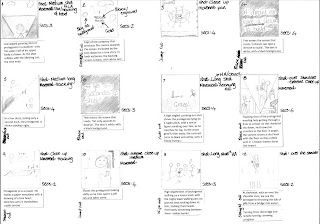Thursday, 1 October 2009
Where Can My products Be Located?
Wednesday, 30 September 2009
Q1) In What Way Does Your Product Use, Develop Or Challenge Forms And Conventions Of Real Media Products?
In order for my products to fulfil their ultimate purposes of attracting the audience into consuming it, I must use, develop and challenge the forms and conventions of real media products.
In my main task of creating a teaser trailer for an upcoming film of a genre of my choice I have, to some extent used a lot of ideas from existing products. The first is the time in which my trailer lasts for; it falls within the 50-90 second boundary that all teaser trailers, regardless of genre, usually last for. I have chosen to use this convention because if my trailer fell outside of these time boundaries, there is a chance that it will be too long to qualify for a teaser trailer or that it will simply be too short and contain too little detail about the narrative of the film. In context, the purpose of a teaser trailer is to tease the audience by creating a sense of enigma, therefore enticing them to consume the full products after completion so by keeping within the time boundaries of existing products, I have been able to give away neither too much, nor too little information regarding the narrative. In the section entitled ‘Codes And Conventions Of A Sports Drama’, I have listed the most common features that tend to appear in majority of films which fall into the same genre as my own. The setting, on a sports pitch, we have used is a common occurrence in real media products, so we decided to use this idea, especially as it matches the genre. The use of the protagonist participating in the sport he loves, on the pitch shows his passion for it, and keeps the key theme of 'sport' playing with the audiences' thoughts.
In order to make my trailer attract my desired audience, I must also develop some of the forms and conventions of real media products. I have done this in my main task of the teaser trailer, by exploring some slightly different themes to those in which existing texts use. In my trailer we chose to to focus on a key theme in detail, the use of drugs and it's effects, not for the protagonists' mind or body, but about how the people they care most about will react to their bad choice in life- whereas real media products, that I have researched 'Save The Last Dance' in which the characters of the narrative are taking drugs as a way of life, our protagonist is taking drugs to help enrich his life for very different reasons.
In order for my product to be a success however, I must also challenge the forms and conventions that are used in real media texts, this is so that the narrative of the trailer cannot be predicted due to the stereotypes that the audience will walk into the cinema with. A key setting of sports dramas is within a prison, this is featured in several films; 'Gridiron Gang', 'Mean Machine' and 'Escape To Victory'. I decided not to use this as a location at all, as I did not want to explore the harsh times associated with prison, this gave me the opportunity then to develop my narrative and explore some more relevant themes that are more likely to be closer to the audience, e.g. the theme of drugs and isolation from friends.
In my subsidiary task of creating a website in order to advertise the main product of the actual film, I must create a site that is going to complete this task effectively I must again, use develop and challenge the forms and conventions of real media products.
I chose to include a contact form on my website, which has been featured on other websites from films from a similar genre, for example; 'Rocky Balboa' and '
In order to make my product unique and different to those that already exist I must also totally invent some elements to contain on my website. On some real media products that I have analysed there are some inspirational quotes from the film, whereas on some others there are none what so ever. I have chosen to develop the idea of featuring some quotes on my website, however, on the real products they are featured across the website and appear in a random sequence when you click from page to page ('
One way in which I have made my product different unique, by challenging the conventions of real media products, is through the use of my background image. I chose to use an image of a road that seems to go on forever, instead of the conventional use of an image either from the film itself, or one set-up from the film- both still featuring the protagonist somewhere on the screen. My justification for doing this is simple; my website is there as a method to promote my film, and entice the audience to go out there and consume the main product, the film, so giving away too much information too early on does not seem like a logical idea to me, as if the actor playing my protagonist is not well known, this will give away the absolute minimal amount of information about him, and will build suspense for when the audience eventually gets to my casts page and sees them. I also chose to use this image because it links with the tagline of the film which is; 'Which Road Will You Take?', and as the image is of a straight road the audience will be led into believing that the protagonists' path is set out clear ahead of him, and in the early stages of the narrative, this is true- however the trailer which is featured on the website will reveal a different story for them.
My film posters, as my second subsidiary task will also need to use, develop and challenge forms of real media products. I decided to replicate the obvious choice of having the protagonist featured on my actual full film poster, as this gives the audience an insight into the cast list. I also chose to use the conventional layout of showing the title of the film in bold letters, with the inclusion of the actor that plays the main protagonist shown above. This could help to promote the film, as if the actor was well known and their name featured on the cover of the film poster, then the audience would be more enticed to consume the product.
Finally, I have also challenge the forms and conventions of real media products (teaser poster), I have chosen to do this because by doing so, I am effectively challenging the stereotypes associated to a particular genre, which will have the effect of keeping the audience on their toes. Challenging too many forms and conventions however, can leave you're audience split as if you challenge them too much, your product will differ too much to that of existing ones and will require your audience to almost change their views on a particular genre, which would be hard to do considering you are challenging the ideas of many iconic films. I have challenged forms and conventions on my teaser poster, by simply totally changing the layout- I chose to not have the main image, one of my protagonist, but of a couple of playing jerseys instead. This has the effect of creating an enigma for the audience consuming the product as they would almost be second guessing who would be in it. This could also have the opposite effect however, whereby the audience are not attracted to it at all because they are not able to see who the main actor is (if they don't recognise their name). However, when employing the spiral effect, where I attained feedback after creating a particular idea- my audience liked this idea, so I decided to keep it this way. I decided in the first place to challenge this convention because of the context of a teaser poster- it is designed to be released a long time before the film (so actors may not have been confirmed, or script totally written, or production even started) and because the whole idea is not to give away too much information, both of which i believe my product does successfully.
For the main poster, I chose to use the conventions of having a mid-shot of the protagonist as the main image, and have again used conventions but not really revealing the genre of the film with this main image. This too, is used in other products such as the Gridiron Gang and Coach Carter posters which I analysed previously in the blog.
However, in both instances they have used a smaller, or blended another image into the background in order for the genre and specific sport to be realised. But because of technological hinderances, it was not possibly for me to do this with such effect, so instead and the way I challenged codes and conventions was through changing the colour of both images into black and white and blending them together in that way. The majority of similar products in the same genre have not changed the colour to black and white, however, I think it works effectively because of the mise-en-scene of the mian image- the indirect mode of address and generally closed body position of the featured character, suggests that times may be hard, and that the colour has been taken out of his life. Which is a definitive link to the narrative of the trailer.
Tuesday, 29 September 2009
Q2) How Effective Is The Combination Of Your Main Product And Subsidiary Tasks?
Monday, 28 September 2009
Q3) What Have You Learned From Your Audience Feedback?
Sunday, 27 September 2009
Q4) How Did You Use New Media Technologies In The Construction And Research, Planning And Evaluation Stages?
New media technologies have been a massive influence in the ways in which the desired audience consume products in today’s world. Newspapers have been around for hundreds of years, but today it is just as easy- and definitely cheaper to consume this product over the Internet.
Almost everything done throughout the production of this piece of coursework I have used the relative new media technology of a computer.
In my planning stages for the subsidiary task of creating a film poster, I decided to find some existing film posters from the same genre that my trailer is going to be for. Once I had discovered one with an iconic image, I decided to replicate it. This gave me the opportunity to familiarise myself with some of the hardware and software I will be expected to use throughout the three tasks. For taking the picture, I used a simple Sony digital camera, once it was uploaded onto my computer I then edited the image using Paintshop Pro.
Also in the planning stages of my production I created a storyboard. Unless you class a pen and pencil under it, this initial stage was not created using any new media technologies- simply because we felt it would be easier to draw the images by hand. Once it was finished however, we used a scanner to upload it onto the computer so we could use it as evidence in our planning stages on our blog (will come back to later).
Whilst conducting my audience research, I discovered that my audience regularly view social networking pages; with the majority being Facebook now that the use of MySpace is becoming ‘out of fashion’. So I entered further research into how I could use a social networking page in order to help me advertise my product. So I have decided that I would use this social networking site as a method of making my product become more known across the World Wide Web.
In the construction stage of my piece I have use the new media technology of a handheld video camcorder. I assumed that the use of this would be easy; however it was much harder than we would have liked. The particular one we used did not upload to a computer easily, instead we had to put it on a
From the research stages, I have used the Internet in order to view existing products, from the analysis of trailers on YouTube to the still images searched and found on Google Images. The use of the Internet is one widely used by basically everyone that has access to it as it is easy to use, yet can sometimes bring in an idea of bias. This problem of bias has to be overcome, as explained in the section entitled ‘Audience Research’ from my blog.
This brings me onto another new media technology that I have used throughout the planning stages of this piece of coursework- blogging on eBlogger. Through this I have managed to document my every move in terms of everything I have done in order to make my main task and subsidiary tasks. Blogger’s simplistic layout makes it easy to use, organise and publish your work onto the Internet making it easy for a potential audience (or you, the examiners) to access and view. I chose to use this site because I had previously heard good feedback about the site, and upon just messing around with it, I realised for myself that this was in fact so.
Linking back to the use of the new media technology of the usage of a computer in order to construct my coursework piece, I have used this in several stages. As stated earlier, by researching, but then once this has been found via the Internet I have chosen to analyse and annotate this on the software package of Microsoft Word 2007. This is a simplistic package to use which is why I chose to use it. I also used this software in order to create my subsidiary task of the film poster, to advertise the film. I learned from my AS piece last year, that this was the easiest package to use, which influenced my decision into using it again.
I also used the Windows Movie Maker package throughout the construction stage, on both the computers available to me at school and at home. I discovered that this was a fairly easy package to use; it has a very basic layout and does not delve into too much technical jargon which could confuse easily.
Saturday, 26 September 2009
Filming and Editing
Friday, 25 September 2009
Audience Feedback- Peer Evaluation
Thursday, 24 September 2009
Shooting Schedule
Wednesday, 23 September 2009
Modifications To Our Narrative
- a love interest for the protagonist, as a spur to achieve the best of his ability
- the protagonist actually taking the drugs, so that he can feels isolated from his team. This also gives us the chance to explore new themes.
This is the agreed final plot of our narrative;
Protagonist trials to get into his Sixth Form/College rugby team. He trains exceptionally well, and eventually gets picked for the starting XV. He continues to train hard in preparation for the first game of the season. Upon kick off, he shows several glimpses of his brilliance- creating good moves, making great tackles and slotting the kicks. However, within 20 minutes of kick off, he gets tackled horribly horribly and injures his knee- this appears to be the end of his game. After going to the hospital and having several scans he is told that he may never run again, making playing rugby again almost impossible. Rugby had been a massive part of his life ever since he could hold a ball and run with it- so this stage in his life became very difficult for him, and his friends and family who had seen this usually overactive person cut down to using crutches to get around anywhere. The protagonist gets offered some performance enhancing drugs by his best friend. He reluctantly accepts them as he has always lived his life by a code of not cheating, but has now realised that this may be the only way to get back out onto the field and play the game he loves. Before a rehabilitation session, his coach discovers the drugs in his bag, and he is dropped from any connection with school rugby as his team and coach have lost total faith in him. The protagonist continues to try and make a comeback, but constantly has the guilt of his reckless actions at the back of his head, so fails to make a lot of progress. He feels as if the game has turned it's back on him and he is not confident that he has enough strength and courage to overcome it. Through the actions of his close family and friends, the protagonist begins to realise that there are more important things in life than rugby but the people around him know how much the game means to him so relentlessly push him to the limit- body and mind- for the opportunity to step back onto the pitch, cleanly. After training relentlessly, 14 months later the protagonist is able to return to full-contact games. His team has made it through the pool and knock-out stages of the Regional Championship Cup, and are now in the final. He returns to the field with 15 minutes left on the clock. At first he finds it hard to compete at this level, especially as he has not gained the full trust of his teammates yet either. With only a few seconds left on the clock and the scores tied, he finds himself in possession of the ball. He drops kicks the ball, revealing some of the skills he had before the injury, the ball dissects the posts, and his team win the game.
Tuesday, 22 September 2009
Storyboard
Monday, 21 September 2009
Film Poster Mock-ups
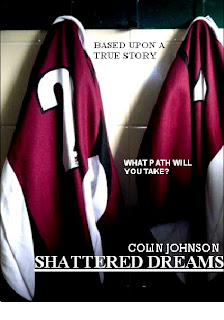
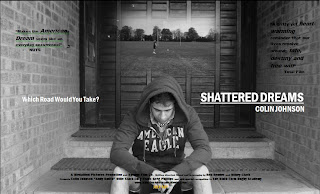
Sunday, 20 September 2009
Marketing Of Films
I researched some successful ways to market films as this is the starting point as to whether a film will become well known before it's release. In the preliminary stages of producing a film, the film company will undertake a large amount of audience research in order to find a potential gap in the market, or just discover what the consumer wants. Once the company has conducted this research, collated and combined the results, they can then start on the product. However, in order for a product to sell, it must be marketed well, so that everyone inside and outside their desired audience pool know about the upcoming production and will put money into it when it is released. If you a film is marketed well, this could be by; advertising the teaser and full-length trailers on television and before films are played at the cinema, create movie posters and have them strategically located where a a lot of people will see them (roadside bus stops, on the side of buses, busy shopping centres etc.), create a website which would be advertised on both the trailers and posters for the audience to visit to get a further in depth look at what the production will be about. This can all however, be influenced by the audience research conducted at the beginning, as it may turn out that only a small percentage watch television or go to the cinema to see films regularly so they may have to consider some other ways to market their production.
In order for my production to be a success, I must too use what I discovered in my audience research discover the best way to market films for my particular target audience.
The use of Facebook to market films
Conventions
- Display photos
- User Information;
Friends
General Public
- Administrators
- Advertising Companies
- Privacy settings~ user can control visible information
- Free for users
- Pay per advert
- Instant messaging
- Global community
- Levi Strauss- binary opposites
- Isolating activity but part of a global community (social)
- Elements of blogging
- Games
- Can personalise homepage (MySpace)
- Add music
- Interaction via music
 The MySpace and Cloverfield Epidemic
Before the film and before even the trailers had been created and released to the public the production company, Paramount Pictures, set up individual MySpace pages for the characters of the film. After making their profiles public and adding thousands of people all of whom believed that these people were real, they started making posts about some of the events that could have happened leading up to the beginning of the film.
The effect of doing that, was so that the public and their followers on MySpace believe that they are real. This had the snowball effect of; when the public watch the film, and see their 'friends' from MySpace in it, with similar events happening in the film to the posts on MySpace, they would believe that these events were really happening- along with the use of a handheld camera used throughout the whole film created a huge sense of realism for the audience.
Strengths of marketing this way;
-It's cheap for the production company;
No cost to establish/set it up
No cost for employing a specialist to do it, as it's also fairly easy to use
- As it's on the Internet, it's easily accessible for both the audience and the user/creator (for changes etc)
Weaknesses of marketing this way;
- Easy to lose all information
- Can be time consuming if a lot of editing is required
The MySpace and Cloverfield Epidemic
Before the film and before even the trailers had been created and released to the public the production company, Paramount Pictures, set up individual MySpace pages for the characters of the film. After making their profiles public and adding thousands of people all of whom believed that these people were real, they started making posts about some of the events that could have happened leading up to the beginning of the film.
The effect of doing that, was so that the public and their followers on MySpace believe that they are real. This had the snowball effect of; when the public watch the film, and see their 'friends' from MySpace in it, with similar events happening in the film to the posts on MySpace, they would believe that these events were really happening- along with the use of a handheld camera used throughout the whole film created a huge sense of realism for the audience.
Strengths of marketing this way;
-It's cheap for the production company;
No cost to establish/set it up
No cost for employing a specialist to do it, as it's also fairly easy to use
- As it's on the Internet, it's easily accessible for both the audience and the user/creator (for changes etc)
Weaknesses of marketing this way;
- Easy to lose all information
- Can be time consuming if a lot of editing is required
Friday, 18 September 2009
Websites Analysis
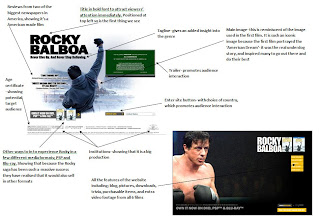
Thursday, 17 September 2009
Analysis of Film Posters
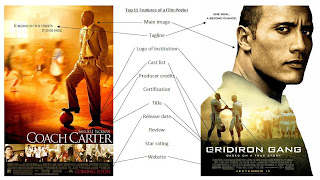
Wednesday, 16 September 2009
Codes And Conventions Of A Sports Drama
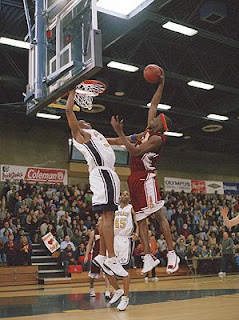 In this still, from the 2005 film Coach Carter, we can see the use of chairs and sports equipment in use as props. The low angled shot and the positioning of his outstretched arm over his rivals, shows that he has the dominance in this shot. The use of sports team attire is also in use.
In this still, from the 2005 film Coach Carter, we can see the use of chairs and sports equipment in use as props. The low angled shot and the positioning of his outstretched arm over his rivals, shows that he has the dominance in this shot. The use of sports team attire is also in use. 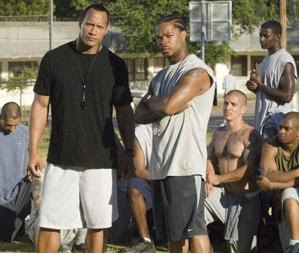
Tuesday, 15 September 2009
Hancock Film Trailer Analysis
Gridiron Gang Film Trailer Analysis
Monday, 14 September 2009
The BBFC
The classification brief, for 12A; Drugs; any misuse of drugs must be misfrequent and not glamorised or give instructional detail Violence; moderate violence is allowed by should not dwell on detail. There should be no emphasis on injuries or blood, but gory moments may be permitted if justified by the context. Sexual violence may only be implied or briefly and discreetly indicated, and must have a strong contextual justification.Source; www.bbfc.co.uk/downloads/pub/Guidelines/BBFC%20Classification%20Guidelines%202009.pdf
Because, in these two sub-sections it could be possible to argue that my trailer breached some of the terms, I have decided to give my trailer an age certificate of 15.
Institutions
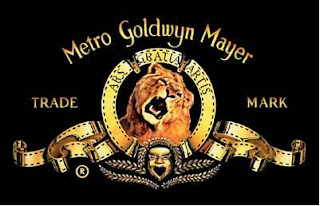 MGM
The use of a lion as the main image shows that it is a predator, hunting the weak as it's at the top of the food chain. The face at the bottom has a mouth shaped like a love heart, revealing their love and passion for the industry. The circle around the lion suggests that they will keep on going and that their successes will continue coming. The gold film tape suggests that they make footage of perfect standard.
MGM
The use of a lion as the main image shows that it is a predator, hunting the weak as it's at the top of the food chain. The face at the bottom has a mouth shaped like a love heart, revealing their love and passion for the industry. The circle around the lion suggests that they will keep on going and that their successes will continue coming. The gold film tape suggests that they make footage of perfect standard.
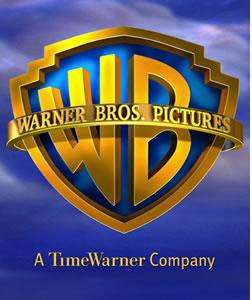 Warner Bros.
Again, being located in the clouds, it suggests that this institution is above all others. The colour gold connotes a sense of wealth and being in the number one position. The logo is shaped like a shield, showing that it will defend it's number one position against any other institutions that possess a threat towards them. The continuous line of gold around the rim of the shield suggests that it will continue releasing products of such quality for a long time to come.
Warner Bros.
Again, being located in the clouds, it suggests that this institution is above all others. The colour gold connotes a sense of wealth and being in the number one position. The logo is shaped like a shield, showing that it will defend it's number one position against any other institutions that possess a threat towards them. The continuous line of gold around the rim of the shield suggests that it will continue releasing products of such quality for a long time to come.
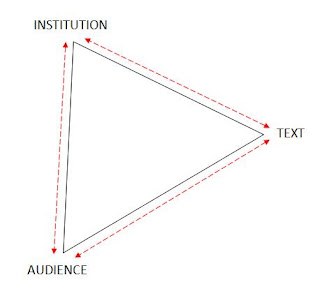 The triangle of dependency show how the institution, text and audience are all linked in a state where all are reliant on eachother. It shows that;
The triangle of dependency show how the institution, text and audience are all linked in a state where all are reliant on eachother. It shows that;
- The institution must constantly adapt their texts in order to meet the demands of their audience, else the institution will get no profit from making any films.
- The institution must initiate some sort of consumer research and find out what their audience want from a new film, or to try and find a gap in the market for a possible new genre or sub-genre. Then create the texts so that when it is released, it will sell well.
- The audience needs the institution to produce new texts in order for there to be some sort of cinematic entertainment for people on a Saturday night- or for orange Wednesdays
- The audience needs the texts to be entertaining to fulfil their requirements (e.g. escapism)
- The texts need the institution in order to be produced and made into a film
- The texts need the audience to view/put money into the product for the institution to get a net gain.

